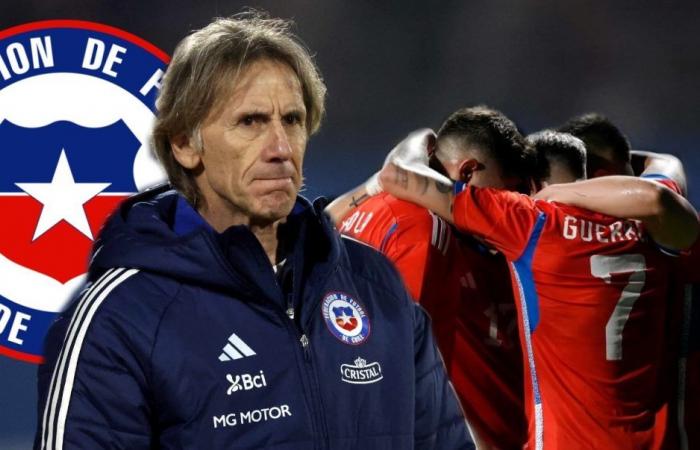06/23/2024 7:41 p.m.Updated on 06/23/2024 8:14 p.m.
It will not be that of Jorge Sampaoli, who won the 2015 Copa América. Nor will it be that of Juan Antonio Pizzi, who won in the United States in 2016. A lot of water has passed through the river, including two World Cups (Russia 2018 and Qatar 2022). that they had him on the other side of the TV, as a mere spectator. But Chile is always Chile. It’s a strong leg. It is solidity. It is verticality. AND, With Ricardo Gareca as the captain of the ship, La Roja will seek to surprise at MetLife Stadium and take him out Argentine National Team his aura of happiness.
Gareca’s Chile: 4-2-3-1, the full-backs and Alexis Sánchez
Since his arrival, the Tiger made something very clear: the Golden Generation will be the Golden Generation forever, but, to be in this Chile 2024 version, they must be in tune with the level of the team, the rivals, the competition. That is why, with the endorsement of the fans and journalism, Gareca decided to dispense with historical figures like Gary Medel (in mouth) and Arturo Vidal (in Colo-Colo).
Both in the friendlies (3-0 vs. Albania, 2-3 vs. France and 3-0 vs. Paraguay), and in their debut in the Copa América against Peru (0-0), Chile came out with a clear 4-2-3-1. However, when building, the Tiger deploys a 2-4-3-1, with the full-backs, Mauricio Isla and Gabriel Suazo, guaranteeing breadth. For their part, the central defense, Igor Lichnovsky – Paulo Díaz, and the double five, Erik Pulgar – Marcelino Núñez, are in charge of getting the ball clean.
Unlike what Eduardo Berizzo proposed (4-3-3), Gareca does not use wingers, but rather three men between the lines, behind the center forward. This movement by Víctor Dávila (on the right) and Diego Valdés (on the left) allows spaces to be opened for the full-backs to occupy the lane. And Alexis will no longer be the child prodigy, but he has a fundamental role in Chile’s attack: As a midfielder, Sánchez moves with greater freedom to receive the ball and occupy free spacesleaving the role of reference for Eduardo Vargas.
The left sector is the most offensive area in Chile. Suazo, together with Alexis Sánchez and Valdés (injured, Osorio would play), create a partnership that allows Chile to break defensive lines with short passes and constant unmarking, taking advantage of the back of the rival right back. Simultaneously, Dávila and Mauricio Isla place themselves in finishing zones, on the right, to accumulate up to seven men in the final third.
Gareca, with a favorable balance in Chile: 2V-1E-1D. (REUTER)
In the defensive phase, Chile is grouped in a 4-4-2 in a middle block, with Dávila and Valdés (now Osorio) covering the wings, while Vargas and Sánchez supporting the first line. In the first minutes, La Roja presses very high to impose rigor. But, as the game progressed, they delayed their position until the middle of the field. AND If something that Chile has very well mechanized and tested is the kickbackaccording to numerical superiority and the position of the ball.
On the defensive side, Chile has shown weaknesses in defending crossed centers with the ball in motion. The central defenders, although they are solid in one-on-one situations, have not been able to guarantee adequate solvency in these situations, forcing Gareca to resort to constant pressing on the wings, even behind 3/4, to avoid dangerous crosses.
Argentina must be attentive to associations on the left wing and take additional defensive precautions. The presence of players like Gonzalo Montiel and Nicolas Tagliaficowith a better record than Nahuel Molina and Marcos Acuña, could be crucial to hinder the rise of the Chilean full-backs, while Scaloni will have to decide between Di María and Nico Gonzalez. It is not necessary to detail the advantage of having Fideo among the 11, but the Fiorentina man, on repeated occasions, has served many times to form a line of five, covering the rival leading marker.
Against Peru, Chile did not go beyond 0-0. (REUTER)
When, where and at what time does Argentina play again in the Copa América?
Argentina’s next rival is Chile, which debuted in the Copa América this Friday with a 0-0 against Peru. The match between Lionel Scaloni’s Albiceleste and Ricardo Gareca’s La Roja will be played on Tuesday, June 25, starting at 10 p.m. (Argentina time). The duel will take place in MetLife Stadium in New Jerseythe imposing stadium with capacity for 80,566 people.
MetLife, ready to receive Argentina-Chile. (AP)
How to watch Argentina’s matches in the Copa América?
All Albiceleste matches in the 2024 Copa América will be broadcast by the broadcast signals. Telefe, TyC Sports, DSports and Public TV. In addition, you will find all the information about these meetings on the website of Oleas usual.
What are the Copa América 2024 groups like?
- Group A: Argentina, Chile, Peru and Canada
- Group B: Mexico, Ecuador, Venezuela and Jamaica
- Group C: United States, Uruguay, Bolivia and Panama
- Group D: Brazil, Colombia, Paraguay and Costa Rica
The Copa América groups, now complete.


